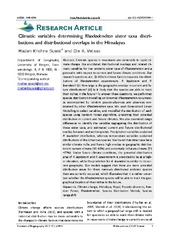| dc.contributor.author | Suwal, Madan Krishna | |
| dc.contributor.author | Vetaas, Ole Reidar | |
| dc.date.accessioned | 2018-06-14T12:21:06Z | |
| dc.date.available | 2018-06-14T12:21:06Z | |
| dc.date.issued | 2017 | |
| dc.identifier.issn | 1948-6596 | |
| dc.identifier.uri | https://hdl.handle.net/1956/17798 | |
| dc.description.abstract | Endemic species in mountains are vulnerable to rapid climate change. We elucidated distributional overlaps and related climatic variables for two endemic sister taxa of Rhododendron and a generalist with respect to current and future climate conditions. Our research questions are: (i) Which climate factors separate the distributions of Rhododendron cowanianum, R. lepidotum and R. lowndesii? (ii) How large is the geographic overlap in current and future distributions? (iii) Is it likely that the species are able to track their niches in the future? To answer these questions, we performed species distribution modelling on binomial Rhododendron occurrences accompanied by random pseudo-absences and absences constrained by other Rhododendron taxa. We used Generalized Linear Modelling to select variables, and modelled the distribution of each species using Random Forest algorithms, predicting their potential distribution in current and future climates. We also examined range differences to identify the variables segregating the distribution of these sister taxa, and estimated current and future distributional overlap between and within species. Precipitation variables explained R. lowndesii distribution, whereas temperature variables explained distributions of the other two species. We found that sister taxa have similar climate niche and hence high overlap in geographic distribution in current climate (46–68%) and potentially in future climate (53–77%). Under future climate conditions, the potential distribution area of R. lepidotum and R. cowanianum is predicted to be at a higher elevation, while the prediction for R. lowndesii is similar to its current geography. Our models suggest that there are more potential distribution areas for these narrowly distributed endemic species than are currently occupied, which illustrates that it is rather uncertain whether the Rhododendron species will be able to track the geographical location of their niches in the future. | en_US |
| dc.language.iso | eng | eng |
| dc.publisher | International Biogeography Society | eng |
| dc.relation.ispartof | <a href="http://hdl.handle.net/1956/17799" target="blank"> Spatial dynamics of species distributions in an anthropogenic landscape in the context of climate change</a> | |
| dc.rights | Attribution CC BY | eng |
| dc.rights.uri | http://creativecommons.org/licenses/by/4.0/ | eng |
| dc.subject | Climate change | eng |
| dc.subject | Himalaya | eng |
| dc.subject | Nepal | eng |
| dc.subject | Pseudo-absences | eng |
| dc.subject | Random Forest | eng |
| dc.subject | Rhododendron | eng |
| dc.subject | Species Distribution Models | eng |
| dc.subject | Species range shift | eng |
| dc.title | Climatic variables determining Rhododendron sister taxa distributions and distributional overlaps in the Himalayas | eng |
| dc.type | Peer reviewed | en_US |
| dc.type | Journal article | en_US |
| dc.description.version | publishedVersion | |
| dc.rights.holder | Copyright the authors | en_US |
| dc.source.articlenumber | e34911 | |
| dc.identifier.doi | https://doi.org/10.21425/F59334911 | |
| dc.identifier.cristin | 1532256 | |
| dc.source.journal | Frontiers of Biogeography | |
| dc.source.40 | 9 | |
| dc.source.14 | 3 | |

